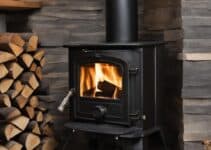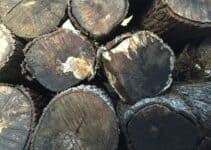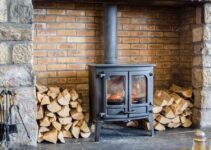A log burner is a great way to heat your home. They’re especially good if you have a big open fireplace and you can even use wood you’ve cut down yourself to save money.
However, if you’re not careful, the glass on the front of the burner can start to go black.
But how do you stop log burner glass from going black? To Stop your log burner glass from going black you can use the right fuels, install a glass door, utilise the airwash system correctly and keep fuel away from the log burner glass.
Read on to find out how to stop log burner glass from going black.
How Do You Keep A Wood Stove Glass From Turning Black?
There are a few things you can do to keep your log burner’s glass pane clean and clear.
Use The Right Fuels
Some fuels, like coal, can produce a lot of soot which will blacken your glass. Use a good quality seasoned hardwood instead, and you’ll be less likely to have this problem.
Keep The Glass Clean – Wood Burner Glass Cleaner
If you’re not using your burner regularly, make sure you keep the glass clean with wood burner glass cleaner. A build-up of soot and ash can cause the glass to blacken over time.
Here’s how to keep wood burner glass clean. Use a soft cloth and some soot remover to get the glass looking shiny and new again. Make sure you use a specially designed stove glass cleaner like this one:
Install A Glass Door
Consider installing a glass door on your burner if you want to keep your glass pane clear. This will stop any ash or soot from landing on the glass and keep it looking good for longer.
Keep Fuel Away From The Glass
When adding fuel to your burner, make sure you’re careful not to let any of it come into contact with the glass. If it does, it can cause the glass to blacken. Keep the fuel at least an inch away from the glass to avoid this problem.
Utilize The Airwash System Correctly
Some burners come with an airwash system which is the best way to clean wood burner glass. Make sure you’re using this system correctly and that it’s set to the right temperature.
If it’s not working correctly, you could end up with a blackened glass pane.
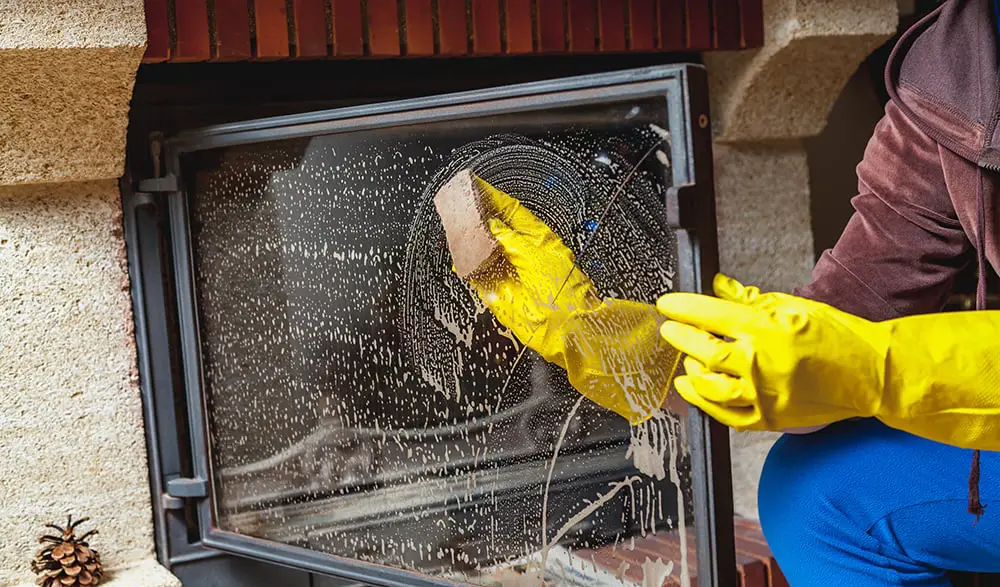
Why Is My Fireplace Glass Turning Black?
There are a few reasons why your fireplace glass might be turning black.
Here are a few of the most common reasons:
Excess Fuel
Excess fuel (wood in this case) doesn’t allow for proper airflow in the firebox, resulting in smoke coming out of the firebox and sticking to the inside of the glass doors.
This is a common problem when homeowners add more logs to keep their homes warm during cold weather.
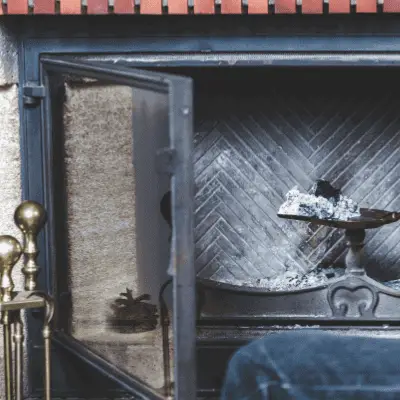
If you notice an issue with excess smoke, try opening the doors wider or adding more air through the damper control.
Unseasoned Wood
An unseasoned wood supply contains a high moisture content that can cause excessive smoke production and buildup on your fireplace glass.
Unseasoned wood also tends to burn at a lower temperature than seasoned wood, causing incomplete combustion and creating more soot.
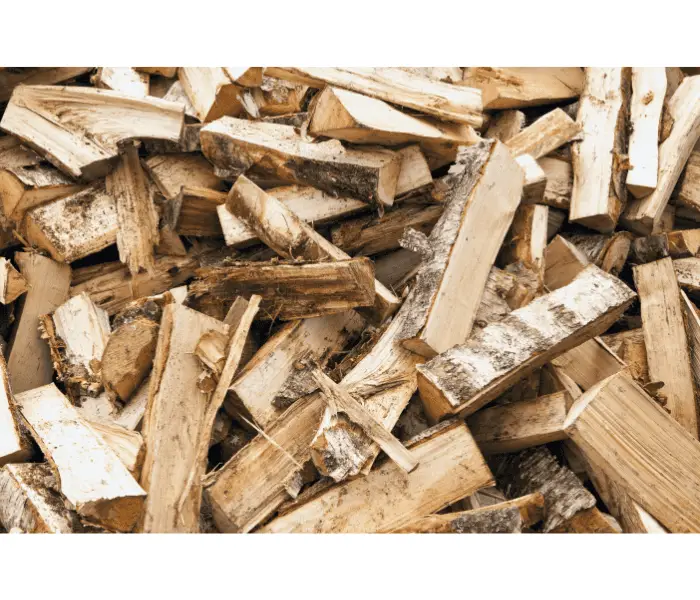
Poor Air Circulation
If your fireplace doesn’t have good air circulation, the smoke and heat will linger in the firebox and cause the glass to turn black. Ensure your damper is open fully and that no obstructions in front of the fireplace might prevent proper airflow.
Wrong Fuel
If you’re using the wrong fuel in your fireplaces, such as coal or oil, it can cause the glass to turn black. Switch to a cleaner-burning fuel like hardwood, and you’ll reduce the amount of soot and ash that lands on the glass.
Fire Glass Turning Black – How To Prevent Soot On Fireplace Glass
A clean fireplace glass door not only looks nice but also improves the efficiency of your fireplace.
If you’ve noticed a buildup of soot on your fireplace glass door, here are several ways to prevent soot on fireplace glass.
Check The Damper For Proper Operation Before Each Heating Season
A damper that doesn’t close completely will allow air and odours into the home but won’t draft well enough to remove combustion gases from the house.
An open damper also allows cold air into the house and wastes fuel by allowing conditioned air to escape through the chimney.
Burn Seasoned Wood
Burning seasoned firewood is one of the best ways to prevent your fireplace glass from getting covered with soot.
Seasoned firewood has been cut and split for at least six months and allowed to dry out before being burned.
This drying process decreases the moisture content in the logs, which allows them to burn at an optimal level.
Burning unseasoned firewood produces more smoke than seasoned wood, increasing creosote buildup in your flue.
Inspect And Clean Chimneys Regularly
A build-up of soot, creosote, and ash can inhibit the flow of air up the chimney and cause your fireplace glass to turn black.
Regular chimney inspections and cleanings will help keep your chimney and fireplace glass clean.
Use An Air-Wash System
An air-wash system is a great way to keep your fireplace glass clean. The air-wash system uses air jets to keep the glass clean while the fireplace is in use.
Make sure the air-wash system is set to the correct temperature and that it’s working properly.
How to Clean Log Burner Glass
We’ve briefly touched on the best way to clean woodburner glass. But cleaning the glass on your log burner is important to maintain good visibility and ensure the efficient burning of wood.
Let’s dive into this step-by-step guide on how to clean the glass on your log burner:
Open the log burner door: A no brainer here but open the door of the log burner to access the glass.
Apply your cleaning solution: If using a commercial cleaner, follow the manufacturer’s instructions. If using a homemade solution, dip the cloth or paper towel in the solution and wring out any excess liquid.
Clean the glass: Gently rub the cleaning solution onto the glass in a circular motion, focusing on any areas with heavy soot or creosote buildup. Be careful not to scratch the glass.
Remove the solution: Use a clean, damp cloth or paper towel to wipe away the cleaning solution and any loosened soot or debris from the glass.
Dry the glass: Finally remove any moisture and streaks by wiping the glass with a dry cloth or paper towel.
Inspect the glass: Check the glass for any remaining soot or residue. If necessary, repeat steps 4-7 until the glass is clean.
Maintain regular cleaning: To keep your log burner glass clean, try to clean it regularly, especially during the burning season. This will make the task easier and prevent the buildup of stubborn stains.
Remember, always follow the manufacturer’s guidelines for cleaning and maintaining your log burner, and ensure the stove is cool before attempting any cleaning.
How to Stop Woodburner Glass Going Black
So now you know how to keep fireplace glass from turning black. Keeping your woodburner glass clean and free from black soot is crucial to maintain its aesthetic appeal and ensure efficient operation.
By selecting the right fuel, using proper burning techniques, and regularly cleaning the glass, you can prevent the buildup of black residue. Hardwood logs and smokeless coal are ideal fuel choices to minimize soot production.
Furthermore, avoid overloading the stove, maintain sufficient airflow, and keep the wood moisture content below 20% to promote efficient combustion. With these simple yet effective tips, you can enjoy the warmth and ambiance of your log burner while maintaining its pristine appearance.

